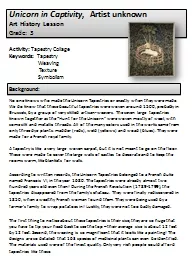

Artist unknown Art History Lesson Grade 3 Activity Tapestry Collage Keywords Tapestry Weaving Texture Symbolism Background No one knows who made the Unicorn Tapestries or exactly when they were made We do know that these beautiful tapestries were wo ID: 419455
Download Presentation The PPT/PDF document "Unicorn in Captivity" is the property of its rightful owner. Permission is granted to download and print the materials on this web site for personal, non-commercial use only, and to display it on your personal computer provided you do not modify the materials and that you retain all copyright notices contained in the materials. By downloading content from our website, you accept the terms of this agreement.
Slide1
Unicorn in Captivity
, Artist unknown
Art History LessonGrade: 3
Activity: Tapestry CollageKeywords: Tapestry Weaving Texture Symbolism
Background:
No one knows who made the Unicorn Tapestries or exactly when they were made. We do know that these beautiful tapestries were woven around 1500, probably in Brussels, by a group of very skilled artisan-weavers. The seven large tapestries known together as the “Hunt for the Unicorn” were woven mostly of wool, with some silk and metallic threads. All of the many colors used in the works came from only three dye plants: madder (reds), weld (yellows) and
woad
(blues). They were made for a French royal family.
A tapestry is like a very large woven carpet, but it is not meant to go on the floor. These were made to cover the large walls of castles to decorate and to keep the rooms warm, like blankets for walls.
According to written records, the Unicorn Tapestries belonged to a French duke named Francois VI, in the year 1680. The tapestries were already almost two hundred years old even then! During the French Revolution (1789-1799), the tapestries disappeared from the family’s chateau. They were finally rediscovered in 1850, when a wealthy French woman found them. They were being used by a farmer’s family to wrap potatoes in! Luckily, they were not too badly damaged
.
The first thing to notice about these tapestries is their size; they are so huge that you have to tip your head back to see the top – their average size is about 12 feet by 12 feet. Second, the weaving is so magnificent that it looks like a painting! The designs are so detailed that 163 species of medicinal plants can even be identified. The materials used were of the finest quality. Only very rich people could afford tapestries like these.
Slide2
The “Unicorn in Captivity” shows a pure white unicorn captured and tied to a pomegranate tree, surrounded by a fence. The flowers in the background garden are called “mille
fleurs”, meaning “thousand flowers”. Red stains on the unicorn’s flank are said to be pomegranate juice. The Unicorn was understood during the Middle Ages to be a mythical beast, symbol of love and purity, and pomegranates were seen as symbols of marriage and fertility, and of immortality. So, it is probably safe to say that these tapestries were made to celebrate an important marriage. Today, the Unicorn Tapestries are hanging in a special room of the Metropolitan Museum of Art in New York City, along with what was believed to be a horn of a unicorn - but is really the spiraled tusk of a narwhal!
Possible Questions:
What is happening in the tapestry?What colors do you see?How do you think the tapestry feels?What animal would represent you?